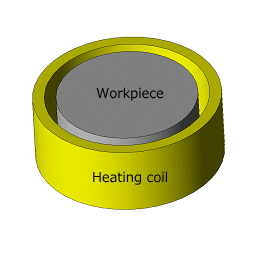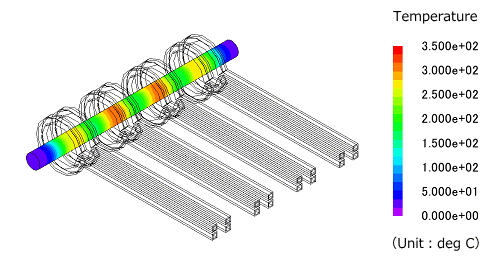Contents
1. Overview
2. Issues
3. Solution to the issue
4. Camshaft induction hardening analysis
4.1 Analysis model
4.2 Mesh model
4.3 Analysis results
4.4 Speedup by parallel processes
5. Summary
6. References
1. Overview
To accurately perform induction heating analysis, it is necessary to generate layered mesh not only on the surface of a workpiece but also on the inside. Conversely, if the mesh is too large, it will not be possible to obtain results within a realistic time so that it might be applied in the design and production workflow.
This document uses as an example an induction heating model to evaluate the performance of the highly parallel solver. As a result, it was found that even in thermal-magnetic field two-way coupled analysis including non-parallel processing such as mapping, a speed-up of 14 times was obtained using 256 parallel (MPP256) in contrast to the 8 parallel (SMP8).
2. Issues
If the layered mesh formed on the surface of a workpiece is determined based on the skin effect at room temperature, then the heat density distribution at high temperatures may not be captured accurately. Verification is performed using the example model shown in Fig. 1. As the temperature rises, the skin depth increases, causing regions where the current flowing on the inside drops significantly (Fig. 2). Errors will, therefore, occur in the event of rough spatial resolution. To suppress these errors, it is necessary to generate a layered mesh not only on the surface but also on the inside of a non-heated body.
Temperature distribution cannot be accurately evaluated in some circumstances due to partial modelling. When handling simultaneous heating for longer objects such as a shaft, a temperature difference will occur between the end and the center in the longitudinal direction of the shaft due to the difference in heat dissipation (Fig. 3). Using full models is, therefore, necessary to capture temperature distribution. This, however, leads to a further increase in model scale.

Fig. 1 Example model

Fig. 3 Temperature distribution due to the simultaneous heating of multiple shafts
You need to sign in as a Regular JMAG Software User (paid user) or JMAG WEB MEMBER (free membership).
By registering as a JMAG WEB MEMBER, you can browse technical materials and other member-only contents for free.
If you are not registered, click the “Create an Account” button.
Create an Account Sign in



